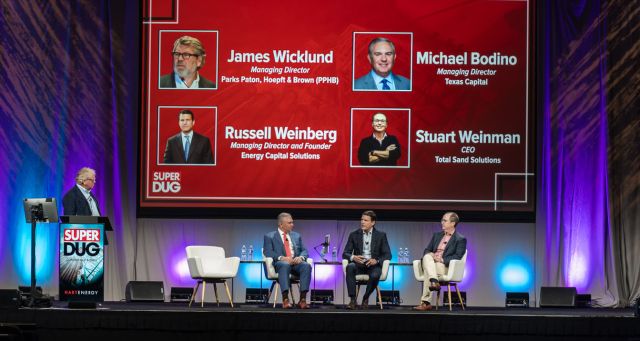
From left to right: moderator James Wicklund, managing director at Parks Paton, Hoepft & Brown; Michael Bodino, Texas Capital Bank managing director; Russell Weinberg, Energy Capital Solutions’ founder and managing director; and Stuart Weinman, Total Sand Solutions CEO. (Source: Hart Energy)
The oil and gas sector is spending upwards of 70% of cash flows, but with the consolidation frenzy sweeping the industry, there’s still an appetite for capital, a number of panelists said during the SUPER DUG Conference & Expo in Fort Worth, Texas.
Companies just need to think creatively to find cash, they concurred.
“It's hard to find good teams, good projects, but there is some capital, especially the acquisition financing,” Michael Bodino, Texas Capital Bank managing director, said May 16 during a panel discussion on financial trends.
Russell Weinberg, Energy Capital Solutions’ founder and managing director, said private equity has “largely left the building,” forcing companies to be “creative to find that capital.” As a result, family offices are attracting and getting a lot of attention, he said.
Weinberg warned that bringing family offices to energy industry investments can be like "herding cats," but said it can be an excellent source for businesses.
Considering the cash flow conundrum, debt is being priced cheaper, Bodino said.
“There's always been a premium paid to get debt, particularly for the users of that capital in this industry. [But] because the balance sheets are so strong, they have a cost of capital advantage versus other industries right now, which is kind of unique,” Bodino said.
Total Sand Solutions CEO Stuart Weinman said there’s a different balance in the risk reward from the institutional side.
In terms of debt, Weinman said the amount of debt that a company needs to consider depended on where the company was in the cycle.
“If you're at the top of the cycle, you probably want to use equity over debt because you can never deflate your way out of the debt problem,” Weinman said. “If you're at the bottom of the cycle, I think you probably want to use a little bit more debt than equity because it's much easier, [and] you can just inflate your way out of that problem.”
But, equity is also available and a number of companies are looking at public markets to access capital, Bodino said.
“We're seeing it across a myriad of energy industries, not just upstream,” Bodino added.
M&A deals continue—and not just for the larger companies, according to Russell Weinberg, Energy Capital Solutions’ founder and managing director.
Panel moderator James Wicklund, managing director at Parks Paton, Hoepft & Brown had an easy suggestion for clients pondering whether they should go public or not.
RELATED: Q&A: PPHB’s James Wicklund on North, South American LNG, Irrational Net Zero Ambitions
"I have spent years telling clients, 'If you want to get rich, don't go public. Sell the company,'" Wicklund said.
Recommended Reading
Nabors SPAC, e2Companies $1B Merger to Take On-Site Powergen Public
2025-02-12 - Nabors Industries’ blank check company will merge with e2Companies at a time when oilfield service companies are increasingly seeking on-site power solutions for E&Ps in the oil patch.
Shell, Canadian Natural Resources to Swap Oil Sands, CCS Interests
2025-01-30 - In a swap transaction, Canadian Natural Resources Ltd. will own 100% interest in the Athabasca Oil Sands Project after acquiring a 10% interest from Shell Canada Ltd. in exchange for a 10% interest in carbon capture and storage facilities.
Elliott Demands Phillips 66 Sell or Spin Off Midstream Biz for $40B+
2025-02-12 - Activist investor Elliott Capital Management disclosed Feb. 11 it has built a $2.5 billion position in Phillips 66 and issued a series of initiatives, including the sale or spinning off of the company’s midstream assets.
Minerals M&A to Heat Up in ‘25 with $4B Diamondback Sale–KeyBanc
2025-01-21 - KeyBanc analysts expect an “imminent” Diamondback Energy dropdown to Viper Energy and at least a couple of $500 million deals by public mineral and royalty companies in 2025, with Sitio Royalties a likely acquirer.
Atlas Energy Solutions to Acquire OFS Power Company Moser for $220MM
2025-01-27 - Atlas Energy Solutions said it will purchase Moser Energy Systems in a cash-and-stock deal that adds power services in the company’s core Permian Basin operating area.
Comments
Add new comment
This conversation is moderated according to Hart Energy community rules. Please read the rules before joining the discussion. If you’re experiencing any technical problems, please contact our customer care team.






